[English] 日本語
 Yorodumi
Yorodumi- PDB-5v90: Crystal structure of ERp29 D-domain in complex with the P-domain ... -
+ Open data
Open data
- Basic information
Basic information
| Entry | Database: PDB / ID: 5v90 | ||||||
|---|---|---|---|---|---|---|---|
| Title | Crystal structure of ERp29 D-domain in complex with the P-domain of calreticulin | ||||||
 Components Components |
| ||||||
 Keywords Keywords | CHAPERONE / protein binding / protein folding | ||||||
| Function / homology |  Function and homology information Function and homology informationregulation of endoplasmic reticulum stress-induced intrinsic apoptotic signaling pathway / Calnexin/calreticulin cycle / response to biphenyl / cytolytic granule / positive regulation of dendritic cell chemotaxis / nuclear receptor-mediated glucocorticoid signaling pathway / Assembly of Viral Components at the Budding Site / ATF6 (ATF6-alpha) activates chaperone genes / cortical granule / negative regulation of trophoblast cell migration ...regulation of endoplasmic reticulum stress-induced intrinsic apoptotic signaling pathway / Calnexin/calreticulin cycle / response to biphenyl / cytolytic granule / positive regulation of dendritic cell chemotaxis / nuclear receptor-mediated glucocorticoid signaling pathway / Assembly of Viral Components at the Budding Site / ATF6 (ATF6-alpha) activates chaperone genes / cortical granule / negative regulation of trophoblast cell migration / complement component C1q complex binding / cellular response to electrical stimulus / response to peptide / regulation of meiotic nuclear division / sequestering of calcium ion / negative regulation of retinoic acid receptor signaling pathway / endoplasmic reticulum quality control compartment / protein folding in endoplasmic reticulum / sarcoplasmic reticulum lumen / negative regulation of intracellular steroid hormone receptor signaling pathway / nuclear export signal receptor activity / cardiac muscle cell differentiation / response to glycoside / cortical actin cytoskeleton organization / Scavenging by Class A Receptors / nuclear androgen receptor binding / Scavenging by Class F Receptors / cellular response to lithium ion / negative regulation of neuron differentiation / response to testosterone / smooth endoplasmic reticulum / hormone binding / protein secretion / molecular sequestering activity / protein unfolding / protein localization to nucleus / negative regulation of protein secretion / positive regulation of cell cycle / ERAD pathway / endocytic vesicle lumen / peptide binding / positive regulation of substrate adhesion-dependent cell spreading / endoplasmic reticulum-Golgi intermediate compartment membrane / protein folding chaperone / positive regulation of endothelial cell migration / acrosomal vesicle / positive regulation of phagocytosis / protein export from nucleus / protein maturation / lumenal side of endoplasmic reticulum membrane / Antigen Presentation: Folding, assembly and peptide loading of class I MHC / intracellular protein transport / peptide antigen assembly with MHC class I protein complex / positive regulation of non-canonical NF-kappaB signal transduction / MHC class I peptide loading complex / cellular response to virus / integrin binding / phagocytic vesicle membrane / intracellular calcium ion homeostasis / cellular senescence / unfolded protein binding / melanosome / nuclear envelope / protein folding / response to estradiol / ER-Phagosome pathway / protein-folding chaperone binding / carbohydrate binding / spermatogenesis / regulation of apoptotic process / postsynapse / negative regulation of translation / positive regulation of MAPK cascade / protein stabilization / ribosome / iron ion binding / response to xenobiotic stimulus / endoplasmic reticulum lumen / negative regulation of gene expression / external side of plasma membrane / focal adhesion / negative regulation of DNA-templated transcription / mRNA binding / positive regulation of cell population proliferation / ubiquitin protein ligase binding / calcium ion binding / endoplasmic reticulum membrane / positive regulation of gene expression / regulation of DNA-templated transcription / perinuclear region of cytoplasm / glutamatergic synapse / cell surface / endoplasmic reticulum / negative regulation of transcription by RNA polymerase II / protein homodimerization activity / mitochondrion / extracellular space / DNA binding / RNA binding / extracellular exosome Similarity search - Function | ||||||
| Biological species |  Homo sapiens (human) Homo sapiens (human) | ||||||
| Method |  X-RAY DIFFRACTION / X-RAY DIFFRACTION /  SYNCHROTRON / SYNCHROTRON /  MOLECULAR REPLACEMENT / Resolution: 3.255 Å MOLECULAR REPLACEMENT / Resolution: 3.255 Å | ||||||
 Authors Authors | Kozlov, G. / Munoz-Escobar, J. / Gehring, K. | ||||||
| Funding support |  Canada, 1items Canada, 1items
| ||||||
 Citation Citation |  Journal: Structure / Year: 2017 Journal: Structure / Year: 2017Title: Mapping the ER Interactome: The P Domains of Calnexin and Calreticulin as Plurivalent Adapters for Foldases and Chaperones. Authors: Kozlov, G. / Munoz-Escobar, J. / Castro, K. / Gehring, K. | ||||||
| History |
|
- Structure visualization
Structure visualization
| Structure viewer | Molecule:  Molmil Molmil Jmol/JSmol Jmol/JSmol |
|---|
- Downloads & links
Downloads & links
- Download
Download
| PDBx/mmCIF format |  5v90.cif.gz 5v90.cif.gz | 95.2 KB | Display |  PDBx/mmCIF format PDBx/mmCIF format |
|---|---|---|---|---|
| PDB format |  pdb5v90.ent.gz pdb5v90.ent.gz | 72.9 KB | Display |  PDB format PDB format |
| PDBx/mmJSON format |  5v90.json.gz 5v90.json.gz | Tree view |  PDBx/mmJSON format PDBx/mmJSON format | |
| Others |  Other downloads Other downloads |
-Validation report
| Summary document |  5v90_validation.pdf.gz 5v90_validation.pdf.gz | 454.9 KB | Display |  wwPDB validaton report wwPDB validaton report |
|---|---|---|---|---|
| Full document |  5v90_full_validation.pdf.gz 5v90_full_validation.pdf.gz | 457.5 KB | Display | |
| Data in XML |  5v90_validation.xml.gz 5v90_validation.xml.gz | 10.6 KB | Display | |
| Data in CIF |  5v90_validation.cif.gz 5v90_validation.cif.gz | 13.2 KB | Display | |
| Arichive directory |  https://data.pdbj.org/pub/pdb/validation_reports/v9/5v90 https://data.pdbj.org/pub/pdb/validation_reports/v9/5v90 ftp://data.pdbj.org/pub/pdb/validation_reports/v9/5v90 ftp://data.pdbj.org/pub/pdb/validation_reports/v9/5v90 | HTTPS FTP |
-Related structure data
| Related structure data | 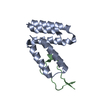 5v8zC 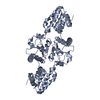 2qc7S C: citing same article ( S: Starting model for refinement |
|---|---|
| Similar structure data |
- Links
Links
- Assembly
Assembly
| Deposited unit | 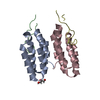
| ||||||||
|---|---|---|---|---|---|---|---|---|---|
| 1 | 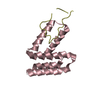
| ||||||||
| 2 | 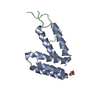
| ||||||||
| Unit cell |
|
- Components
Components
| #1: Protein | Mass: 11903.626 Da / Num. of mol.: 2 / Fragment: UNP residues 158-261 Source method: isolated from a genetically manipulated source Source: (gene. exp.)  Homo sapiens (human) / Gene: ERP29, C12orf8, ERP28 / Plasmid: pET-SUMO / Production host: Homo sapiens (human) / Gene: ERP29, C12orf8, ERP28 / Plasmid: pET-SUMO / Production host:  #2: Protein/peptide | Mass: 4665.040 Da / Num. of mol.: 2 / Fragment: UNP residues 238-273 Source method: isolated from a genetically manipulated source Source: (gene. exp.)  Homo sapiens (human) / Gene: CALR, CRTC / Plasmid: pET15b / Production host: Homo sapiens (human) / Gene: CALR, CRTC / Plasmid: pET15b / Production host:  #3: Chemical | ChemComp-GOL / | |
|---|
-Experimental details
-Experiment
| Experiment | Method:  X-RAY DIFFRACTION / Number of used crystals: 1 X-RAY DIFFRACTION / Number of used crystals: 1 |
|---|
- Sample preparation
Sample preparation
| Crystal | Density Matthews: 2.98 Å3/Da / Density % sol: 64.33 % |
|---|---|
| Crystal grow | Temperature: 293 K / Method: vapor diffusion, sitting drop / pH: 7.5 / Details: 2.0 M ammonium sulfate, 0.1 M HEPES pH 7.5 |
-Data collection
| Diffraction | Mean temperature: 100 K |
|---|---|
| Diffraction source | Source:  SYNCHROTRON / Site: SYNCHROTRON / Site:  CHESS CHESS  / Beamline: A1 / Wavelength: 0.6307 Å / Beamline: A1 / Wavelength: 0.6307 Å |
| Detector | Type: ADSC QUANTUM 210r / Detector: CCD / Date: Nov 12, 2015 |
| Radiation | Protocol: SINGLE WAVELENGTH / Monochromatic (M) / Laue (L): M / Scattering type: x-ray |
| Radiation wavelength | Wavelength: 0.6307 Å / Relative weight: 1 |
| Reflection | Resolution: 3.25→50 Å / Num. obs: 6735 / % possible obs: 99.4 % / Redundancy: 9.7 % / Rsym value: 0.106 / Net I/σ(I): 19.1 |
| Reflection shell | Resolution: 3.25→3.31 Å / Redundancy: 10.2 % / Mean I/σ(I) obs: 6.9 / Num. unique all: 632 / Num. unique obs: 368 / Rsym value: 0.494 / % possible all: 100 |
- Processing
Processing
| Software |
| ||||||||||||||||||||||||||||
|---|---|---|---|---|---|---|---|---|---|---|---|---|---|---|---|---|---|---|---|---|---|---|---|---|---|---|---|---|---|
| Refinement | Method to determine structure:  MOLECULAR REPLACEMENT MOLECULAR REPLACEMENTStarting model: 2QC7 Resolution: 3.255→43.34 Å / SU ML: 0.38 / Cross valid method: THROUGHOUT / σ(F): 1.34 / Phase error: 29.68
| ||||||||||||||||||||||||||||
| Solvent computation | Shrinkage radii: 0.9 Å / VDW probe radii: 1.11 Å | ||||||||||||||||||||||||||||
| Refinement step | Cycle: LAST / Resolution: 3.255→43.34 Å
| ||||||||||||||||||||||||||||
| Refine LS restraints |
| ||||||||||||||||||||||||||||
| LS refinement shell |
|
 Movie
Movie Controller
Controller



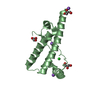
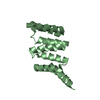
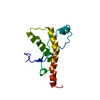
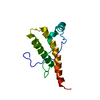
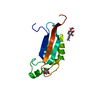
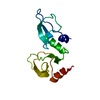

 PDBj
PDBj








